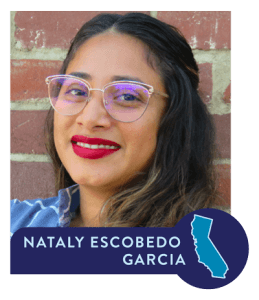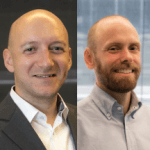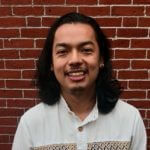Lessons from the Network: Nataly Escobedo Garcia
 Nataly is Policy Coordinator, Water Programs at Leadership Counsel for Justice and Accountability. Leadership Counsel “fundamentally shifts the dynamics that have created the stark inequality that impacts California’s low income, rural regions. Based in the San Joaquin and Eastern Coachella Valleys, we work alongside the most impacted communities to advocate for sound policy and eradicate injustice to secure equal access to opportunity regardless of wealth, race, income, and place.”
Nataly is Policy Coordinator, Water Programs at Leadership Counsel for Justice and Accountability. Leadership Counsel “fundamentally shifts the dynamics that have created the stark inequality that impacts California’s low income, rural regions. Based in the San Joaquin and Eastern Coachella Valleys, we work alongside the most impacted communities to advocate for sound policy and eradicate injustice to secure equal access to opportunity regardless of wealth, race, income, and place.”
This interview was conducted on July 8, 2021. It has been lightly edited for clarity.
River Network (RN): To get started, can you give me a brief introduction to who you are, your role at Leadership Counsel for Justice and Accountability, and how you first got involved with drinking water issues?
Nataly Escobedo Garcia (NEG): My name is Nataly and I am a Policy Coordinator for Leadership Counsel for Justice and Accountability. I support our policy advocates who do work around water, so I’m a little bit of a research arm for Leadership Counsel, where I support with information residents want around water, as well as our state efforts around water, which includes legislation, state budget work and, as of recently I’ve actually supported residents with testing their water.
RN: There are many facets related to clean drinking water, including issues of access, quality, affordability, and safety. Where do you focus your work?
NEG: Affordability is something that we’re working on statewide. We pursued legislation around affordability in the past and we were actually a big part of passing the Safe and Affordable Drinking Water Fund. On quality, that varies, we have communities that have issues for contamination. I work with a community in Eastern Coachella Valley that has arsenic contamination in their water. We work with other communities that are dealing with other contaminants like nitrates and [Trichloropropane].
A lot of our work right now is revolving around drought, because we are in California, where drought is essentially a new normal for us. It’s very likely that we’re going to have droughts, due to the impacts of climate change, from now on, and right now we are already seeing communities who have been left without water in their homes. So, we’re working on drought advocacy efforts.
RN: In your drought planning work with smaller systems, can you give a brief overview of what that actually looks like? I guess I’m curious—if there’s literally just not water available, what do you do to be resilient?
NEG: So, the idea behind the bill would be that small water systems, right now, are not required to have drought contingency planning, to do drought contingency planning, that’s for the urban water suppliers that supply water to more than 10,000 connections, I believe. And so, this bill would require them to have a plan in place so when drought does happen, they have steps that they can take. This obviously cannot happen without funding from the state to give these smaller systems technical support, so they can have proper planning. For us, ideally proper drought planning would include emergency consolidation into a stable water system in the long term. For the short term, having a plan in place for getting water tanks, getting bottled water delivery, drilling deeper wells, depending on what each water system needs. Just making sure that there is a plan in place so if a system is left without water or their water is contaminated—because that’s something that’s often not discussed about during drought—that it’s not just an issue of [water] levels. Contamination increases for certain contaminants like nitrates. It’s really important to make sure that systems have a plan in place but it’s equally important that they have as many resources and support as possible to make that happen.
The whole western part of the US, mostly the southwest but a good chunk of the western part is in drought conditions. It’s interesting when trying to actually look at different states to see how they manage water, what policies they have in place. It can be sometimes difficult to draw from places on the east coast, because they have such a different hydrological reality that we do. Granted flooding… California is the state of extremes, it is either extremely wet or extremely dry and we don’t seem to have an in between.
Flooding is a pretty big problem, but because it just isn’t happening as often anymore it’s something that we haven’t invested as many resources and infrastructure into addressing. So, in cases like that it definitely would be worthwhile to draw from the east coast, but the extreme dryness is a very Southwestern experience and we also have radically different systems in place then say, Texas or Arizona.
RN: You mentioned that you’re working at local and state levels, do you do any work at the federal level in terms of policy advocacy or coalition work?
NEG: No, that we haven’t engaged on as much. At least when it comes to water it’s already complicated enough at the state level, to really engage at the federal level.
RN: Access to clean drinking water intersects with public health, environmental justice, climate resiliency, and other issues tied to our health and well-being, like housing. How does your work fit into these broader systems?
NEG: So actually, the community that I work with directly is at that intersect. The community of Oasis Mobile Home Park has had unclean water for years now, but their issues of unclean water are also very much connected to issues of lack of affordable housing in the Eastern Coachella Valley, which often leads communities to live in mobile home parks that are dilapidated, that are not sustainable for the long term as it’s getting hotter and hotter in California and the rest of the country. These homes are just not well equipped to actually deal with extreme heat and because there hasn’t been enough affordable housing built out in Riverside County. Communities are pushed to live in these mobile parks that are dependent on groundwater systems and arsenic contamination is rampant in that part of the aquifer. It’s naturally occurring so unfortunately there’s not much remediation that’s possible.
But a safer solution would be to live in affordable housing that’s already connected to a water district where there’s water and wastewater infrastructure, so they’re unfortunately at the intersect of housing, energy, and other pollution problems.
RN: Leadership Counsel for Justice and Accountability worked to pass Assembly Bill 685, the Human Right to Water in California, as well as subsequent drinking water bills, like Senate Bill 200, which provided funding to the Safe and Affordable Drinking Water Fund. What was the impetus to develop and implement these policies?
NEG: I mean, even right to water was a really great first step, and it definitely opened up funding for communities who desperately needed it. Unfortunately, it’s been a slow step. You know there’s still hasn’t been formal policy developed at different agencies like the Department of Water Resources, Department of Public Health, who do have to uphold the human right to water. It also doesn’t apply to the ones actually managing and controlling the water, which are the water districts and just local actors who obviously are the ones who, in a lot of ways, are responsible for the water injustices that the communities we work with face. And, in general, when it comes to funding those review process can be so lengthy. Consolidation, has been a big piece of bringing folks access to clean and safe water but consolidation projects take a really long time, usually we’re looking at a three-to-five-year timeline at best.
RN: In terms of maybe more recent work, such as creating the funding for the safe and affordable drinking water fund, can you tell me a little bit, if you were involved in that, the process around community engagement or public input to gain traction for that?
NEG: That was a very much a community driven effort. Different communities that we work with in the San Joaquin Valley were involved in that… I was around, but I wasn’t working on that campaign when we were getting that passed. But it was definitely community driven. Folks went up to the capital to give testimony in order to make sure that this was passed.
RN: How do you build support with other stakeholders besides community members? What kind of work do you do with elected officials or agency employees, and also water management service providers?
NEG: We’re definitely very active in terms of accountability. We facilitate conversations between water districts and their customers, same with local electeds, we support communities being able to get meetings with local electeds to make sure their needs are being represented. We are active participants at city board meetings, county board meetings, we participate in many different planning processes, including general plan adoption, most recently groundwater sustainability plan adoptions. As well as urban water management plan adoptions. That necessitated having conversations with various water district, local electeds, other nonprofits that also advocate for safe drinking water.
RN: Going off of that, how do you all decide where to focus your energy because I imagine you have limited resources and you’re putting a lot of time and effort into all these different planning processes and things like that… how do you decide what to focus on?
NEG: Usually it’s community who makes that decision, not us, we’ll invest our energies in where community feels the need is at. So last year, when the pandemic began even my work shifted more towards Covid support because that’s what the community needed at the moment. So that meant getting folks connected to resources, helping them with rental assistance applications. Our efforts, our work, is based on what community wants us to work on, so usually that’s how we identify the projects we end up working on.
RN: Are there other organizations that you partnered and build effective coalitions with? You all are part of the Safe and Affordable Drinking Water Fund Coalition— could you tell me a little bit about how you go about building coalitions with other groups to advance your work?
Nataly Escobedo Garcia: We often partner with other water advocacy groups, and Community Water Center is a big one that we work with, Clean Water Action, usually if our missions align, we try our best to make sure we’re working in partnership with folks on a collective goal. We’ve certainly done that a lot with our water work.
RN: Passing a bill or resolution is a big accomplishment, but we know it isn’t the end of the story. Can you describe what implementation has looked like so far? Are you continuing to work with affected communities and/or state agencies to make sure policies and programs are actually being well implemented?
NEG: Implementation is definitely—passing a bill is not easy—but implementing it can be that much harder. We’ll actively monitor the process and make sure that residents are involved through different aspects of the process. We actually have folks that we work with who are on the advisory group for the Safe and Affordable Drinking Water Fund. So that has been one way we monitor that process. Other ways we monitor is just continuing to work closely with the agencies who are either receiving the funding or are going to be implementing the policies or bills or legislation to make sure that that process continues to be community driven.
RN: What are the major campaigns or policy priorities that you’re currently working on? What kind of strategies are you using to advance your goals?
NEG: Yeah, so we have a couple of bills that we’re working on this legislative season. SB 552, the one that I’ve been involved with, is drought planning for small water systems. We have pretty active social media campaigns around a lot of the bills that we’re supporting or working on, but we also have active community participation in that process. Often residents will testify at hearings, they help shape what the language looks like based on their needs and what they’re looking to see change at the state. So that’s one of the policies that we’re working on.
We’re also big proponents of water debt relief. It’s estimated that there’s about a billion dollars’ worth of water debt as a result of the pandemic, so we engage heavily in the state budget process to ensure some of those priorities were included there and thankfully there was quite a bit of funding that was allocated for water debt relief.
RN: I read that you are currently pursuing your PhD and I’m just wondering how you are juggling everything in your life, it seems impressive.
NEG: I mean, I know I’m lucky in a lot of ways. One, I’m in an interdisciplinary program that has really opened up the amount of tools that I can use to understand California water. Two, I also do adopt more hands-on methodology, I was trained in anthropology so ethnography is a big a piece of that. I’ve incorporated different ethnographic methods into my research, which has allowed me to spend time with communities. Actually, originally when I came to Leadership Counsel I was just looking to volunteer for the organization and I was able to establish a relationship with the organization, and they ended up offering me a position. Especially to help out around a lot with the research. It also helps- a lot of the work that I do for the organization is research which is literally what I’m being trained in to do so, my day to day would have looked very similar to what my day to day at this job looks like where I’ve dedicated the last seven years now to just understanding every aspect of California water that I could come across. I kind of got really lucky that there was a lot of overlap between my dissertation work and the work I do here.
RN: Well, that sounds really like a lovely fit, I’m so glad that you found each other. My last question is, working with LCJA, what’s your biggest accomplishment to date or what aspect of your work are you most proud of?
NEG: Actually, we were just able to get a budget allocation! I work with the community of Oasis Mobile Home Park, which I mentioned had been dealing with contaminated water for years and have had an emergency order on their system from the EPA for almost two years now. And conditions have just continued to deteriorate at the park and residents are actually- we’re representing them in an active lawsuit against their now deceased landlord. But part of relocation efforts included us working with our local Representative house member Garcia to get in a budget ask of $30 million for relocation.
And thanks to an incredible effort from the community, that was passed just last week. I mean, like I said, passing it, in some ways is the easy part. Right now, implementing those funds is definitely going to be a lot of work but I’m beyond proud of the work that I’ve gotten to do with the residents of Oasis Mobile Home Park and it’s just it’s been incredible to learn so much courage, bravery, and grace from them.
Nataly’s advice for working in the water field:
Just in terms of California water and folks who are interested in a career in California water, I would highly encourage folks to just really think big and outside the box. We’re coming to a point where our law and policy just doesn’t reflect our hydrological reality. And I think it’s definitely about time we move in a different direction, and for that to happen we’re going to need a lot of creative voices in the space.







